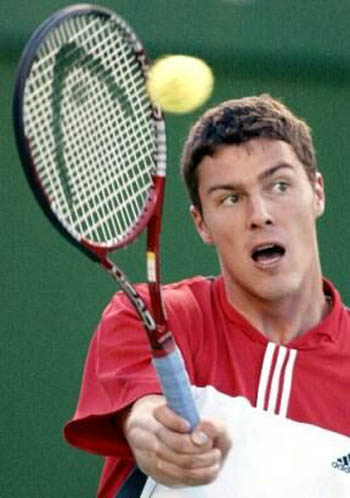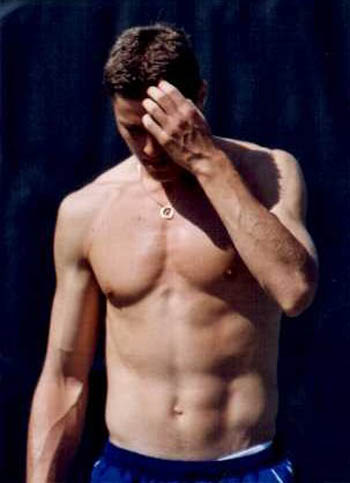Russian Tennis player – Marat Safin, Marat Safin, Marat Safin Fitness Male Model, Marat Safin male model, Marat Safin male model photo, Marat Safin model gallery, Marat Safin muscular man, Marat Safin international model, Marat Safin model international, Marat Safin muscular photo, Marat Safin muscular gallery, Marat Safin muscular fitness, Marat Safin muscular model, Marat Safin photo, Marat Safin gallery, Marat Safin news, Marat Safin video, Marat Safin model
Russian Tennis player – Marat Safin
Marat Safin was born in Moscow on 27th January 1980 to Misha and Rausa Islanova. It has been said that Marat Safin is a born champion. His mother, Rausa, was a former top 10 Russian player who used to take baby Marat with her when she practiced at the local Spartak club, which was managed by his father, Mikhail.

Marat began to play tennis at the age of 6. Rausa served as her son’s coach from ages 6 to 13. At the age of 13, with the training facilities and opportunities in Russia almost non-existent, Marat and his mother visited a tennis academy in Valencia. There they met Maria Pasqual, former director of Spanish women?s tennis, who was asked to assess his potential. Pasqual recognized the enormous natural talent of the young Marat and persuaded a wealthy Swiss client into sponsoring Marat and keeping him at the academy.
So, at the age of 14, Marat left home to travel to Spain. All alone, Marat was faced with the prospect of learning a new language and honing his tennis skills in a foreign land. Over the next 4 years, Marat trained in Valencia under the guidance of Pasqual and Rafael Mensua. During this time, Marat learned to speak Spanish fluently, and it is one of the three languages that he speaks.
In 1997 Marat moved more than 200 ranking positions with an 11-5 match record in Challenger play. He won his first title in Espinho, and soon afterwards turned pro. Marat made his Pro Tour debut at the Kremlin Cup in Moscow, losing to Carlsen in the 1st round.
In 1998 Marat grabbed the attention of the game’s best as well as the sponsors when he stormed into Roland Garros and upset Andre Agassi in the first round. He then went on to take out the defending champion Gustavo Kuerten in the next round before eventually losing to Cedric Pioline in the fourth round. He also made his first tour semifinal in Long Island and reached the fourth round of the US Open where he lost to Pete Sampras. By the end of the year, Safin had gained nearly 150 ranking spots and had finished the year in the Top 50. Marat was named the RADO Player to watch for 1998.

His upward climb continued during his second year on tour. In 1999, he was the No. 2 Russian (behind world No. 2 Kafelnikov). Marat won his first ATP title in Boston defeating Greg Rusedski while only dropping one set in five matches. He was also one of three teenagers (Ferrero, Hewitt) to win an ATP title during year. Marat helped Russia to the Davis Cup SF by winning fifth and decisive matches in 1st round and quarterfinal ties.
In February, Marat advanced to back-to-back semifinals in St. Petersburg and Rotterdam. During the clay court circuit, he advanced to the 4th round at Roland Garros for the second straight year and in August, made it to the semifinal in Amsterdam.
During the European indoor circuit in November, he reached his first TMS final in Paris with wins over No. 5 Kuerten, Courier (QF) and Chang (SF) before losing to Andre Agassi in four sets. He has also reached the last 16 round of 3 of the 5 Grand Slams he participated in. All of these accomplishments saw Marat reach the top 25 ranking for the first time in his career.
The year 2000 was both up and downhill for Marat. After a less than promising start that was highlighted by a few difficulties, Marat turned his year around with back-to-back titles in Barcelona and Mallorca. By this time he was working with former Top 10 Andrei Chesnokov as a coach. Like with all thrill rides, Marat made a quick and stunning run along the circuit and in a very brief time had captured his first Tennis Masters Series title in Toronto, and made the final in Indianapolis. His coaching carousel began with the subsequent hiring and firing of two more coaches, Alexander Volkov and Tony Pickard.
The highlight of Marat’s young career came weeks later when he won his first Grand Slam title at the US Open, where he demolished former champion Pete Sampras in the final.
The following week he made the long journey to Tashkent and only dropped one set in five matches. He became first player to win an ATP title the following week of a Grand Slam title since Ivan Lendl in 1985. He continued his strong play by winning the TMS Paris title, defeating Philippoussis in a 3 hour 29 minute marathon.

Marat’s training on the red clay of Spain was paying off as he was one of four players to win at least 25 matches on clay (25-9) and hard (36-15) courts. He led the ATP in aces (921).
Marat let the ATP with seven titles and held the number 1 ranking spot for a short time. He became youngest player to finish No. 2 since 19-year-old Boris
Becker in 1986… He also became first player under age of 21 to win at least seven titles in a season since Mats Wilander. He led ATP in singles matches won (73), finals reached (9) and was second in singles matches played (100).
He entered his first Tennis Masters Cup in Lisbon with a 75-point lead in ATP Champions Race over Kuerten and was twice within one victory of becoming youngest year-end No. 1. He was named ATP Most Improved Player of Year and named 2000 Newcomer of the Year at Laureus World Sports Awards in Monte Carlo.
2001 was another year of ups and downs. Marat started strong with a 4th round in the Australian Open and a final in Dubai. However, a back injury cramped Safin’s play and set him back for 3 months. He began working with former No. 1 Mats Wilander at this time. He made his turnaround at All England Club where he reached his first QF, losing to eventual champion Goran Ivanisevic in four thrilling sets. Marat then reached the semi-finals at the US Open and successfully defended his titles in Tashkent and St. Petersburg. He finished 2001 just outside the Top Ten at No. 11.
After a disappointing and injury plagued 2001, Marat came into the new year of 2002 ready to rumble. He pounded his way to the Australian Open final, beating Pete Sampras and Tommy Haas along the way, but he stumbled in the final, losing to Thomas Johansson. The final was played on Marat’s 22nd birthday, but despite the disappointing loss, he gave one of his famous witty speeches and the Swedish fans even sang happy birthday to him.

During the clay court circuit, Marat reached the final of TMS Hambürg without dropping a set, before losing to Roger Federer. He continued his strong play at Roland Garros where he reached the semifinal for the first time before losing to Ferrero. Marat struggled in the next two Grand Slam tournaments, losing in the 2nd RD at Wimbledon and the US Open. His relationship with Mats Wilander ended in the middle of this year and Marat began working with his manager, Amit Naor, and his good friend Denis Golovanov, as coaches. Eventually Naor stopped travelling with Marat but his relationship with him continues, just not as a coach.
Marat managed to salvage another disappointing year with a win over the world’s number 1 player Lleyton Hewitt at the TMS Paris. Given a newfound confidence, he went on to lead Russia to their first ever Davis Cup victory. He again was one of the top 8 players in the world to reach the Tennis Masters Cup in Shanghai.